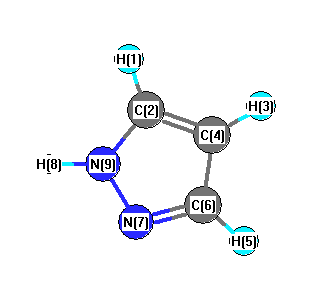Vibrational Frequencies calculated at MP2/SDD
| Mode Number |
Symmetry |
Frequency
(cm-1) |
Scaled Frequency
(cm-1) |
IR Intensities
(km mol-1) |
Raman Act
(Å4/u) |
Dep P |
Dep U |
|---|
| 1 |
A' |
3686 |
3558 |
92.51 |
|
|
|
| 2 |
A' |
3302 |
3188 |
1.43 |
|
|
|
| 3 |
A' |
3284 |
3170 |
4.90 |
|
|
|
| 4 |
A' |
3267 |
3154 |
1.48 |
|
|
|
| 5 |
A' |
1513 |
1460 |
13.39 |
|
|
|
| 6 |
A' |
1437 |
1387 |
15.96 |
|
|
|
| 7 |
A' |
1403 |
1354 |
8.92 |
|
|
|
| 8 |
A' |
1336 |
1290 |
3.89 |
|
|
|
| 9 |
A' |
1229 |
1186 |
2.15 |
|
|
|
| 10 |
A' |
1145 |
1105 |
2.28 |
|
|
|
| 11 |
A' |
1116 |
1077 |
14.94 |
|
|
|
| 12 |
A' |
1056 |
1019 |
12.19 |
|
|
|
| 13 |
A' |
999 |
964 |
22.03 |
|
|
|
| 14 |
A' |
921 |
889 |
3.81 |
|
|
|
| 15 |
A' |
908 |
877 |
7.29 |
|
|
|
| 16 |
A" |
797 |
770 |
0.03 |
|
|
|
| 17 |
A" |
762 |
736 |
107.73 |
|
|
|
| 18 |
A" |
691 |
667 |
130.92 |
|
|
|
| 19 |
A" |
672 |
648 |
13.82 |
|
|
|
| 20 |
A" |
627 |
605 |
0.03 |
|
|
|
| 21 |
A" |
594 |
573 |
34.46 |
|
|
|
Unscaled Zero Point Vibrational Energy (zpe) 15371.7 cm
-1
Scaled (by 0.9653) Zero Point Vibrational Energy (zpe) 14838.3 cm
-1
See section
III.C.1 List or set vibrational scaling factors
to change the scale factors used here.
See section
III.C.2
Calculate a vibrational scaling factor for a given set of molecules
to determine the least squares best scaling factor.
